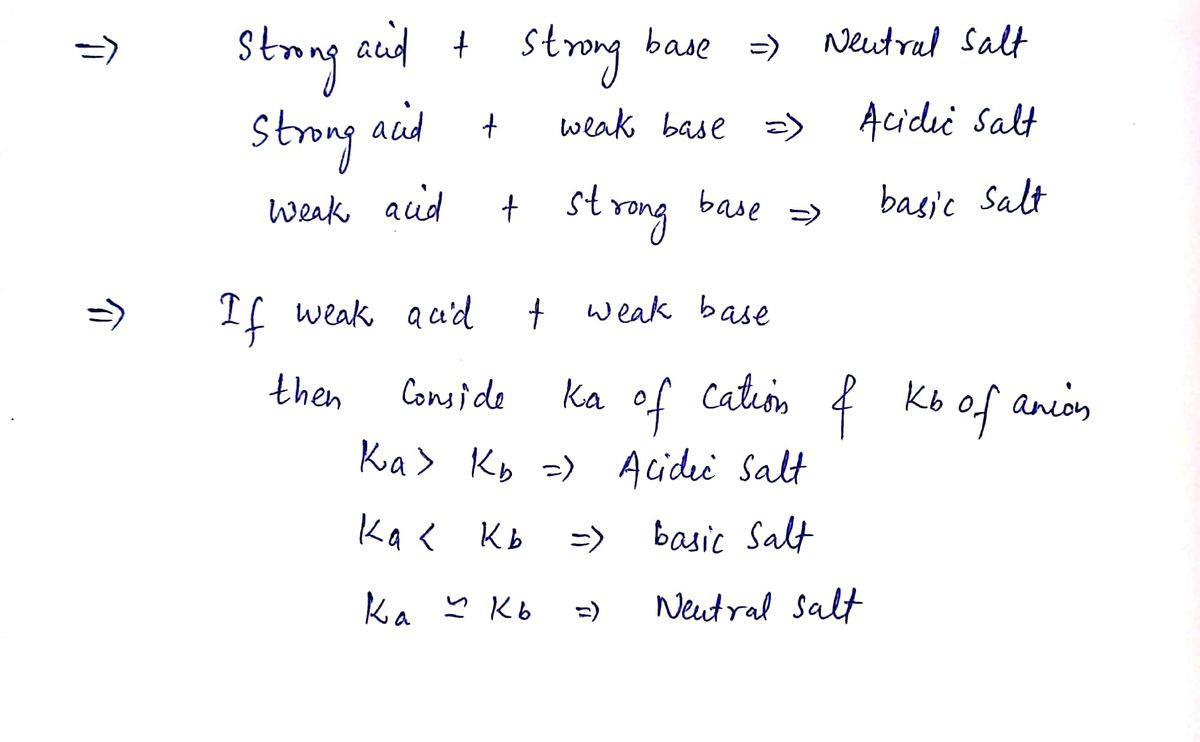Identify the following salts as neutral, acidic, or basic. Drag each item to the appropriate bin. ▸ View Available Hint(s) NH,CIO. LiF|LiNOr |KCN NHCN NHBr SrBrz Neutral salts Acidic salts Reset Help Basic salts
Ionic Equilibrium
Chemical equilibrium and ionic equilibrium are two major concepts in chemistry. Ionic equilibrium deals with the equilibrium involved in an ionization process while chemical equilibrium deals with the equilibrium during a chemical change. Ionic equilibrium is established between the ions and unionized species in a system. Understanding the concept of ionic equilibrium is very important to answer the questions related to certain chemical reactions in chemistry.
Arrhenius Acid
Arrhenius acid act as a good electrolyte as it dissociates to its respective ions in the aqueous solutions. Keeping it similar to the general acid properties, Arrhenius acid also neutralizes bases and turns litmus paper into red.
Bronsted Lowry Base In Inorganic Chemistry
Bronsted-Lowry base in inorganic chemistry is any chemical substance that can accept a proton from the other chemical substance it is reacting with.
![**Acid-Base Properties of Salt Solutions**
Salt is an ionic compound that is produced when a cation and an anion from an acid-base reaction combine, and solutions of salts can be neutral, acidic, or basic, depending on the acid-base properties of the constituent cations and anions.
Since strong acids and bases completely ionize in solution, the reaction essentially runs to completion forming the salt. Therefore, salts formed by reaction of a strong acid with a strong base are neutral. NaCl formed by the neutralization of NaOH and HCl is a neutral salt.
Salts formed by reaction of a strong acid with a weak base are acidic, and salts formed by reaction of a weak acid with a strong base are basic. This is due to the equilibrium the conjugate has with its acid or base. For example, sodium bicarbonate NaHCO₃ contains the conjugate of the weak acid H₂CO₃. The conjugate will reform the acid through the equilibrium:
\[ \text{HCO}_3^- \ (\text{aq}) + \text{H}_2\text{O} \ (\text{aq}) \leftrightharpoons \text{H}_2\text{CO}_3 \ (\text{aq}) + \text{OH}^- \ (\text{aq}) \]
and, thus, acts as a weak base. A solution of NaHCO₃ yields a basic solution.
If a salt is derived from a weak acid and a weak base, the pH of the solution depends on the relative acid strength (Kₐ) of the cation and base strength (K_b) of the anion. If Kₐ > K_b, the solution of the salt is acidic. If Kₐ < K_b, it is basic. If Kₐ ≈ K_b, it is neutral.
---
**Part B**
**Identify the following salts as neutral, acidic, or basic.**
Drag each item to the appropriate bin.
- **Available Salts**: NH₄ClO₄, LiF, LiNO₃, KCN, NH₄CN, NH₄Br, SrBr₂
- **Bins**:
- Neutral salts
- Acidic salts
- Basic salts
(There are draggable options for sorting salts into categories based on their acid-base properties. The user is prompted to classify each salt.)](/v2/_next/image?url=https%3A%2F%2Fcontent.bartleby.com%2Fqna-images%2Fquestion%2Feefb1497-b9c5-4c51-aa29-e7bc635506b5%2Fda57634c-2b1b-4eb8-ba71-5cf70da87483%2F3vn8r0r_processed.jpeg&w=3840&q=75)

Step by step
Solved in 3 steps with 3 images









